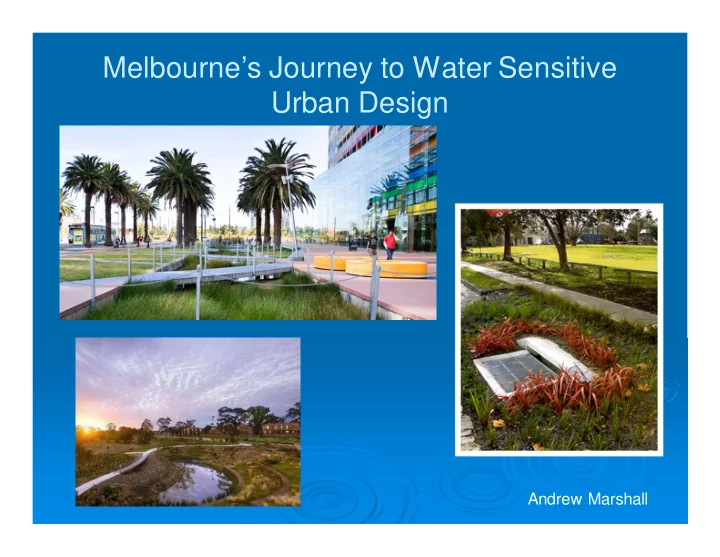

Melbourne’s Journey to Water Sensitive Urban Design Andrew Marshall
Outline Set the scene (Australia vs Canada) The development process in Victoria The origins of WSUD Implementation issues Lessons learned Solutions Innovation
A tale of two countries Canada 9 984 670 sq. km 33 000 000 Australia Reliefweb.int 7 659 861 sq. km 21 000 000 thierry.raguier.free.fr
A little perspective Ontario 1 076 395 sq. km Victoria 237 000 sq. km Toronto go-passport.grolier.com Webspace.webring.com 7 100 sq. km (gta) 5 500 000 Melbourne 8 800 sq. km 4 000 000
An extreme climate Climate Rainfall Temperature extremes Black Saturday Fires theage.com.au February 7, 2009 46.4 degrees in Melbourne Previous week had three straight days of 43 degrees or higher 173 deaths Worst natural disaster in Australian history theage.com.au Threatened water supply reservoirs theage.com.au
Development in Victoria State government Local (single tier) VPPs vs LPPs Planning Schemes Amendment process Role of GAA UGB PSPs gaa.vic.gov.au
Water Management MW MW provision sewage & drinking water Responsible for waterway health Wholesale Retail (YVW etc) Flooding SRW Irrigation DSE
melbournewater.com.au Rainfall
The Big Dry
melbournewater.com.au The Big Dry
The Big Dry
The Big Dry
The Big Dry Drought proofing strategies theage.com.au Desalination Third pipe Stormwater harvesting yvw.com.au Even with the drought Melbourne almost generates enough stormwater runoff to meet its needs Wong 2009
Stormwater, friend and foe Initially concerned only about flooding Concern about water quality in the Bay Led people to theage.com.au question the way stormwater is managed theage.com.au
Problems and Solutions CSIRO study Advent of WSUD Clause 56.07 Hot bed of WSUD technology Culture of stormwater ‘thinkers’ monash .edu.au/ fawb
Clause 56 and the new way of doing things Clause 56.07 Integrated Water Management for Residential Subdivision Introduced October 9 2006 Applies to all new vacant lots in: Residential Zones wsud.org Mixed Use Zones
Clause 56.07 continued… Four objectives and standards Drinking Water Supply Fundamentally unchanged Reused and Recycled Water Dual pipe infrastructure provided to lots where required by retail water authorities Wastewater Management Fundamentally unchanged Stormwater Management The major changes! raingardens.melbournewater.com.au
Clause 56.07 continued… Key change: Need to meet Urban Stormwater Best Practice Environmental Management (USBEPM) Guidelines: 80% reduction in TSS 45% reduction in TP 45% reduction in TN 70% reduction in Gross Pollutants (litter) Maintain flow discharges at pre-development levels (1.5- wsud.org year ARI) Requires on-site treatment through WSUD
The roll out Consultation sessions were conducted prior to policy introduction Jan 2007 - Melbourne Water funded Clearwater’s Senior Stormwater Policy Advisor role to assist councils with the implementation Information sessions with most of the 38 councils in MW area Assistance with WSUD technology and modelling Assistance with policy application
Change ain’t easy Fundamental shift in the way stormwater is managed Turned nearly 80 years of engineering practice on its head Went from hard treatments (pipes, concrete channels) to soft ones (swales, wetlands, raingardens) Cultural resistance to change Perception of cost-shifting
Issues What the heck is WSUD? Councils’ inability to influence type of WSUD inherited Concerns over councils’ ability to maintain WSUD systems Lack of interdepartmental communication Is it a garden or infrastructure? Inconsistency between individual council employees (knowledge, practical experience) Loopholes in policy (land use, infill) Lack of relevance to inner city councils
Responding to the challenge Clearwater Support Stormwater team Living Rivers • Funding • Projects such as • Street tree pits in urban areas • RG in suburbs • Learn through experience raingardens.melbournewater.com.au
raingardens.melbournewater.com.au
Responding to the challenge Regional Stormwater projects • Capacity Building • Tools • Big wetlands Leadership/Liaison
Empowering local councils Growth Area Guidelines Regional areas Parent document / local council specific Empowering for councils Greater control and certainty over what is built Certainty up-front for developers Have been rolled out in the 2 largest growth areas around Melbourne
Empower and Equip Regional networks Councils work best when they learn from each other Regional networks to work on common issues Inter-disciplinary • Maintenance • Directors Seminars & presentations Engineering Institute Surveyors Institute Councils Work with state government GAA DPCD PLANET
Lessons learned over time Importance of E&S C Multidisciplinary teams Get WSUD recognized EARLY in planning process (PSP) gaa.vic.gov.au Regular contact within each council (committee) Continuous improvement Sustained capacity building Freedom for creativity and innovation Wong 2009
If you build it… 50 regional wetlands since program inception Together they remove 100 tonnes of TN per year Dandenong Valley Wetland 2009 48ha 5000T TSS melbournewater.com.au 9T TP 28T TN
Blazing the trail Lynbrook Construction commenced in July 1999 1700 lots Combination of WSUD & traditional 271 lots are solely WSUD Area of WSUD drainage is 55ha Swales Then wetland Won the President’s Award from UDIA melbournewater.com.au
Innovation is now mainstream Mernda 277 lots 40 raingardens Regional wetland University Hill Mixed use universityhill.com.au Wetlands
Greenfields are easy…what about a retrofit? Royal Park Wetlands Wong 2009
Greenfields are easy…what about a retrofit? Raingardens Tanks on existing lots Storm calculator melbournewater.com.au
Pushing the boundaries Toolern Green field 60,000 people 2300 ha Mixed use 1800 ha residential gaa.vic.gov.au Innovation is possible Australia’s first Water Neutral suburb (August 24, 2011)
Pushing the boundaries Kalkallo Industrial stormwater harvest and reuse Treating to potable standards Werribee ASR mabcorp.com.au Riverwalk dev’t 198 ha Raingardens Tanks Online wetlands Potential to send to Werribee ASR site, then supply back to residents Western Plains ‘Big Roofs’ vicurban.com
Key points WSUD (LID) is a useful method to treat stormwater quality & quantity Change takes time and needs resources Sustained support No ‘one size fits all’ solution Can enable stormwater to be used as a resource Once you have the foundations anything is possible
Useful Links melbournewater.com.au clearwater.asn.au watersensitivecities.org.au www.ewater.com.au/ www.storm.melbournewater.com.au/ www.urbanstreams.unimelb.edu.au/cwalsh
Recommend
More recommend